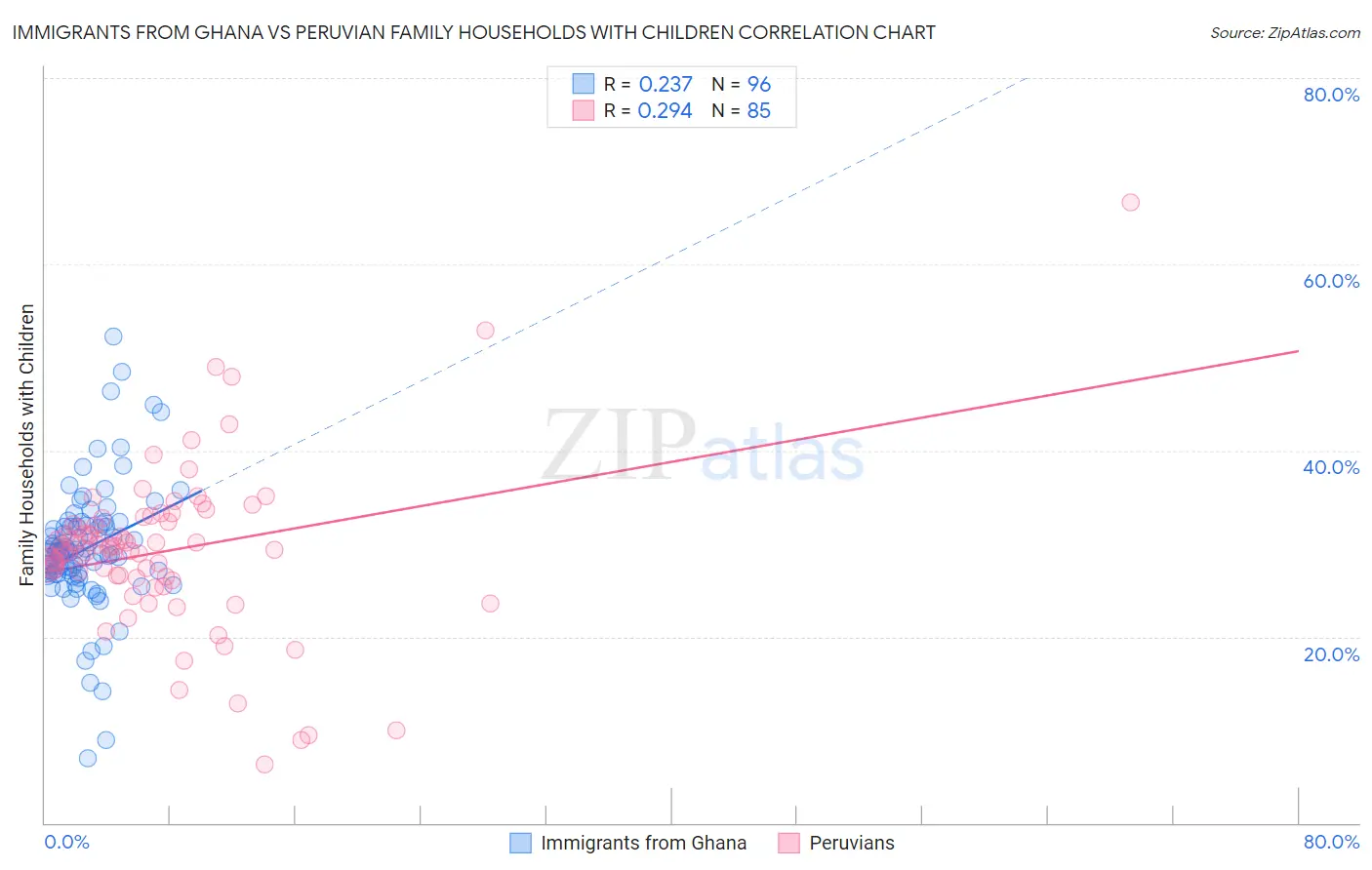Immigrants from Ghana vs Peruvian Family Households with Children
COMPARE
Immigrants from Ghana
Peruvian
Family Households with Children
Family Households with Children Comparison
Immigrants from Ghana
Peruvians
28.6%
FAMILY HOUSEHOLDS WITH CHILDREN
99.9/ 100
METRIC RATING
61st/ 347
METRIC RANK
29.0%
FAMILY HOUSEHOLDS WITH CHILDREN
100.0/ 100
METRIC RATING
47th/ 347
METRIC RANK
Immigrants from Ghana vs Peruvian Family Households with Children Correlation Chart
The statistical analysis conducted on geographies consisting of 199,783,452 people shows a weak positive correlation between the proportion of Immigrants from Ghana and percentage of family households with children in the United States with a correlation coefficient (R) of 0.237 and weighted average of 28.6%. Similarly, the statistical analysis conducted on geographies consisting of 362,805,667 people shows a weak positive correlation between the proportion of Peruvians and percentage of family households with children in the United States with a correlation coefficient (R) of 0.294 and weighted average of 29.0%, a difference of 1.5%.

Family Households with Children Correlation Summary
| Measurement | Immigrants from Ghana | Peruvian |
| Minimum | 7.0% | 6.2% |
| Maximum | 52.2% | 66.7% |
| Range | 45.3% | 60.4% |
| Mean | 29.5% | 29.2% |
| Median | 29.1% | 29.5% |
| Interquartile 25% (IQ1) | 26.8% | 26.3% |
| Interquartile 75% (IQ3) | 31.9% | 32.5% |
| Interquartile Range (IQR) | 5.2% | 6.2% |
| Standard Deviation (Sample) | 6.9% | 8.9% |
| Standard Deviation (Population) | 6.9% | 8.8% |
Demographics Similar to Immigrants from Ghana and Peruvians by Family Households with Children
In terms of family households with children, the demographic groups most similar to Immigrants from Ghana are Egyptian (28.6%, a difference of 0.0%), Immigrants from Lebanon (28.6%, a difference of 0.010%), Hmong (28.6%, a difference of 0.070%), Filipino (28.6%, a difference of 0.080%), and Immigrants from Nigeria (28.6%, a difference of 0.13%). Similarly, the demographic groups most similar to Peruvians are Immigrants from Philippines (29.0%, a difference of 0.010%), Apache (29.0%, a difference of 0.030%), Fijian (29.0%, a difference of 0.090%), Jordanian (29.0%, a difference of 0.12%), and Immigrants from Taiwan (29.0%, a difference of 0.15%).
| Demographics | Rating | Rank | Family Households with Children |
| Immigrants | Taiwan | 100.0 /100 | #44 | Exceptional 29.0% |
| Fijians | 100.0 /100 | #45 | Exceptional 29.0% |
| Immigrants | Philippines | 100.0 /100 | #46 | Exceptional 29.0% |
| Peruvians | 100.0 /100 | #47 | Exceptional 29.0% |
| Apache | 100.0 /100 | #48 | Exceptional 29.0% |
| Jordanians | 100.0 /100 | #49 | Exceptional 29.0% |
| Immigrants | Immigrants | 100.0 /100 | #50 | Exceptional 28.9% |
| Immigrants | Peru | 100.0 /100 | #51 | Exceptional 28.9% |
| Guatemalans | 100.0 /100 | #52 | Exceptional 28.9% |
| Immigrants | Cambodia | 100.0 /100 | #53 | Exceptional 28.9% |
| Sierra Leoneans | 100.0 /100 | #54 | Exceptional 28.9% |
| Immigrants | Asia | 100.0 /100 | #55 | Exceptional 28.8% |
| Immigrants | Guatemala | 100.0 /100 | #56 | Exceptional 28.8% |
| Danes | 100.0 /100 | #57 | Exceptional 28.7% |
| Hawaiians | 100.0 /100 | #58 | Exceptional 28.7% |
| Immigrants | Nigeria | 100.0 /100 | #59 | Exceptional 28.6% |
| Hmong | 99.9 /100 | #60 | Exceptional 28.6% |
| Immigrants | Ghana | 99.9 /100 | #61 | Exceptional 28.6% |
| Egyptians | 99.9 /100 | #62 | Exceptional 28.6% |
| Immigrants | Lebanon | 99.9 /100 | #63 | Exceptional 28.6% |
| Filipinos | 99.9 /100 | #64 | Exceptional 28.6% |